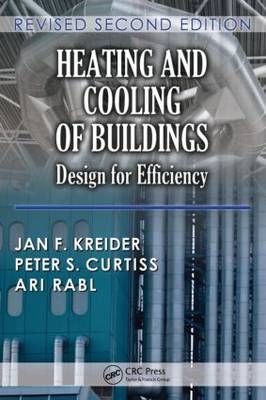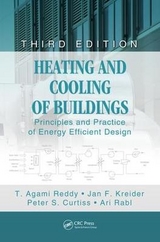
Heating and Cooling of Buildings
Crc Press Inc (Verlag)
978-1-4398-1151-1 (ISBN)
- Titel erscheint in neuer Auflage
- Artikel merken
The art and the science of building systems design evolve continuously as designers, practitioners, and researchers all endeavor to improve the performance of buildings and the comfort and productivity of their occupants. Retaining coverage from the original second edition while updating the information in electronic form, Heating and Cooling of Buildings: Design for Efficiency, Revised Second Edition presents the technical basis for designing the lighting and mechanical systems of buildings.
Along with numerous homework problems, the revised second edition offers a full chapter on economic analysis and optimization, new heating and cooling load procedures and databases, and simplified procedures for ground coupled heat transfer calculations. The accompanying CD-ROM contains an updated version of the Heating and Cooling of Buildings (HCB) software program as well as electronic appendices that include over 1,000 tables in HTML format that can be searched by major categories, a table list, or an index of topics. Ancillary information is available on the book’s website www.hcbcentral.com
From materials to computers, this edition explores the latest technologies exerting a profound effect on the design and operation of buildings. Emphasizing design optimization and critical thinking, the book continues to be the ultimate resource for understanding energy use in buildings.
Jan F. Kreider is the president of Kreider and Associates, LLC, a renewable energy and energy efficiency consulting firm in Boulder, Colorado. He is also Professor Emeritus at the University of Colorado, Boulder, where he was the founding director of the Joint Center for Energy Management. Peter S. Curtiss is a consulting engineer specializing in energy use simulation and analysis, process control, and distributed generation technologies. He runs an engineering consulting business in Boulder, Colorado. Ari Rabl is a retired senior scientist at the Centre Energétique et Procédés de l’Ecole des Mines in Paris, France. He continues to work as a consultant for the government and industry.
Introduction
A Bit of History
Importance of Buildings in the U.S. Economy
Role of HVAC Design Engineer
A Note on the Economics of Energy Efficiency
Units and Conversions
Orders of Magnitude
Elements of Heat Transfer for Buildings
Introduction to Heat Transfer
Conduction Heat Transfer
Convection Heat Transfer
Radiation Heat Transfer
Evaporation and Moisture Transfer
Closure
Review of Thermodynamic Processes in Buildings
Introduction to Thermodynamics
Thermodynamic Properties
First Law of Thermodynamics
Second Law of Thermodynamics and Thermodynamic Cycles
Summary
Psychrometrics, Comfort, and Health
Introduction and Definitions
Thermodynamic Fundamentals
The Psychrometric Chart and Tables of Air Properties
Psychrometric Processes for Buildings
Thermal Comfort
Air Quality and Ventilation
Summary
Fundamentals of Fluid Mechanics in Building Systems
Introduction
Basic Concepts
Pressure Losses in Liquid and Air Systems
Prime Movers
Flow Measurement
Summary
Solar Radiation and Windows
Solar Geometry
Extraterrestrial Insolation
Insolation Data and Models
Sol-Air Temperature
Windows
Heating and Cooling Loads
Air Exchange
Principles of Load Calculations
Storage Effects and Limits of Static Analysis
Zones
Heating Loads
CLTD/CLF Method for Cooling Loads
Transfer Functions for Dynamic Load Calculations
New Methods for Load Calculations
Summary
Annual Energy Consumption and Special Topics
Annual Consumption
Thermal Networks
Other Models
System Identification
Comparison of Calculations with Each Other and with Measured Data
Summary of Methods
Heat Generation and Transfer Equipment
Introduction
Natural Gas and Fuel Oil-Fired Equipment
Electric Resistance Heating
Electric Heat Pumps
Heat Exchanger Design and Selection
Low-Temperature Radiant Heating
Solar Heating
Cogeneration Definition and Overview
Summary
Cooling Equipment
Introduction
Rankine Refrigeration Cycle
Absorption Cycle
Mechanical Cooling Equipment—Chillers
Part-Load Performance of Chillers
Rules for Chiller System Operation and Control in Commercial Buildings
Evaporative Cooling Equipment
Summary
Secondary Systems for Heating and Cooling
Air Distribution Systems
Piping Design
Complete HVAC Systems for Commercial Buildings
HVAC System Design Sizing and Energy Calculations
Summary
Heating, Ventilating, and Air Conditioning Control Systems
Introduction—The Need for Control
Basic Control Hardware
Basic Control System Design Considerations
Examples of HVAC System Control Systems
Topics in Advanced Control System Design
Summary
Lighting
Principles of Lighting
Electric Lighting
Principles of Daylighting
Analysis of Daylighting
Design for Efficiency
The Road to Efficiency
Design Elements and Recommendations
Performance Indices for Heating and Cooling
Measured Performance
Residential Buildings
Commercial Buildings: HVAC Systems
Design for Daylighting
Costs
Comparing Present and Future Costs
Life Cycle Cost
Economic Evaluation Criteria
Complications of the Decision Process
Cost Estimation
Optimization
Nomenclature
Appendix
Index
Problems and References appear at the end of each chapter.
| Erscheint lt. Verlag | 7.1.2010 |
|---|---|
| Reihe/Serie | Mechanical and Aerospace Engineering Series |
| Zusatzinfo | over 600 equations; 110 Tables, black and white; 335 Illustrations, black and white |
| Verlagsort | Bosa Roca |
| Sprache | englisch |
| Maße | 178 x 254 mm |
| Gewicht | 1724 g |
| Themenwelt | Technik ► Bauwesen |
| ISBN-10 | 1-4398-1151-2 / 1439811512 |
| ISBN-13 | 978-1-4398-1151-1 / 9781439811511 |
| Zustand | Neuware |
| Informationen gemäß Produktsicherheitsverordnung (GPSR) | |
| Haben Sie eine Frage zum Produkt? |
aus dem Bereich



